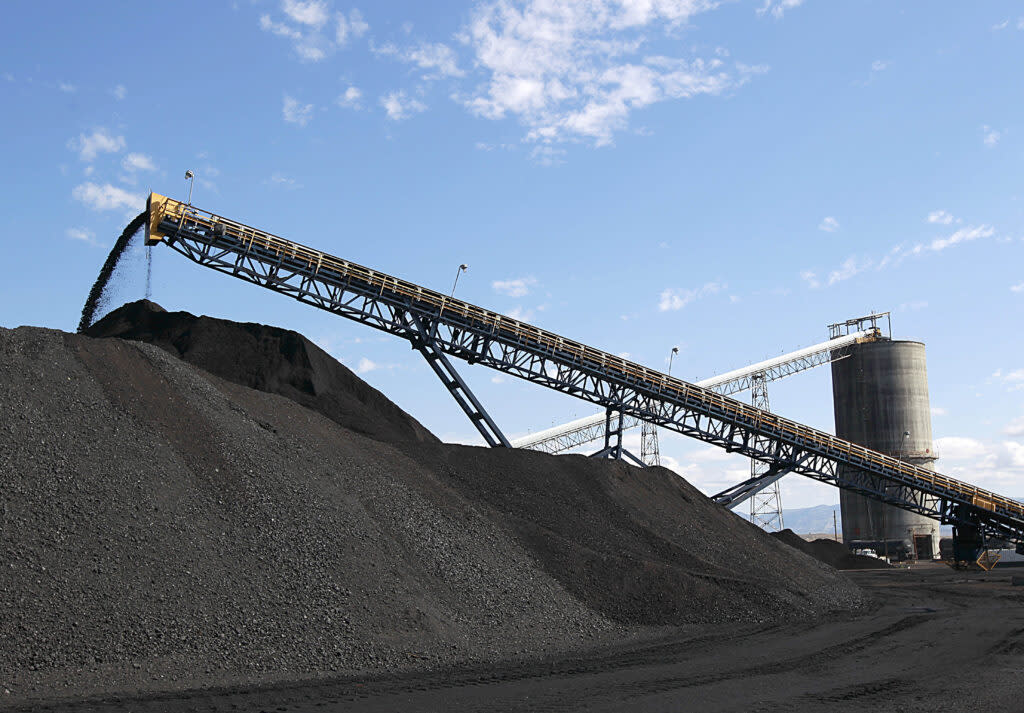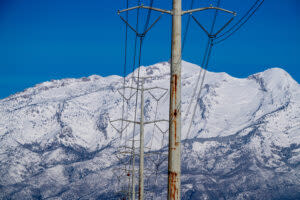Utah joins lawsuit against EPA rule to control emissions from coal plants

Coal falls off a conveyer belt as it's off loaded from trucks from local coal mines at the Savage Energy Terminal on Aug. 26, 2016 in Price, Utah. Utah joined a legal challenge against a new EPA rule that would require a substantial reduction greenhouse gas emissions from coal and natural gas plants. (Photo by George Frey/Getty Images)
For Utah, implementing the Environmental Protection Agency’s stricter standards for greenhouse gas emissions from fossil fuel-fired energy plants sounds like an impossible task. As the agency finalizes the rule, the state is simultaneously working on an implementation plan and a lawsuit to the federal government.
On Monday, Utah joined 24 other states issuing a challenge to the rule, requesting the U.S. Court of Appeals for the District of Columbia Circuit to declare the regulations unlawful. The states’ attorneys general argue that “the final rule exceeds the agency’s statutory authority and otherwise is arbitrary, capricious, an abuse of discretion and not in accordance with the law.
The finalized rule tackling existing coal-powered units and new gas facilities is effective on July 8, according to the Federal Register.
GET THE MORNING HEADLINES DELIVERED TO YOUR INBOX
Under the new rule, the state has to draft a plan that would identify the compliance pathway for coal units to meet the 2032 deadline the federal government is requiring in order for generators to continue operating.
The standards require power plants that are planning on operating in the long-term to control 90% of their carbon pollution by 2032, or close down. The agency also tightened emissions standards for toxic metals by 67% and approved a 70% reduction in the emissions parameters for mercury from existing lignite-fired sources, according to the EPA.
The change has been criticized by Utah lawmakers and utility officers who say that controlling the plants’ carbon dioxide emissions with carbon capture and sequestration technologies — a process that captures and stores carbon dioxide in underground geologic formations — would be a hardship, as they are not available at a utility scale.
Utah doesn’t have authority to store carbon, Bryce Bird, director of the Utah Division of Air Quality told the Public Utilities, Energy and Technology Interim Committee on Wednesday. And, the state also has other challenges to meet the 2032 deadline.
“We’d have to build the extra expertise in house to analyze and develop a plan, but my understanding is it wouldn’t be possible to implement it on the timeframes that are outlined in the rule,” Bird said.
The fact that the carbon capture and sequestration technologies are identified as the best system to reduce emissions, even though implementation isn’t possible, “probably is good grounds for a challenge to the rule,” Bird added.

The cost of installing carbon capture technologies would be in the area of $1 billion per unit, James Owen, vice president for environmental, fuels and mining at PacifiCorp, told the committee on Wednesday.
In Owen’s view, the federal government is using environmental regulation to quickly retire fossil fuel resources, specifically coal. And that decision will be “heavily litigated,” he said.
If the rule survives the legal challenges, it would impact PacifiCorp’s Hunter and Huntington plants in the early 2030s, he said
“I do not believe that it’s EPA’s intent to actually have carbon capture installed on the unit that it’s requiring. It’s simply a measure to try to increase the cost and force those units to move to something else,” Owen said.
David Crabtree, president and CEO of Deseret Power, a generation and transmission cooperative, told the committee he believes that mandating the technology is unlawful, because the technology is not ready. Also, he said, “the mandated timing is not even in the realm of possibility.”
The National Rural Electric Cooperative Association filed a different legal challenge to the rule, stating the regulation was “unlawful, unreasonable and unachievable. It exceeds EPA’s authority and poses an immediate threat to the American electric grid,” its CEO Jim Matheson said in a news release.
The commitments to implement carbon storage to reduce the emissions have to be made soon, Crabtree said, and the cooperative is uncertain they’ll be able to fulfill the goals, which would mean a forced closure of coal-fueled power plants.
“Any regime that forces a discontinuation of that fuel in favor of a different fuel technology exceeds the authority of the EPA for setting a system of emission reductions,” Crabtree said.
After reading a statement from the North American Electric Reliability Corporation warning that EPA regulations would make the grid vulnerable in case of extreme weather events, Rep. Carl Albrecht, R-Richfield, said legislation passed this year delaying coal plant retirements “is only a temporary Band-Aid.”
“Folks, we’re on the edge. Rocky Mountain is on the edge, Deseret is on the edge,” Albrecht
said. “We’ve got to fight back. That’s all we can do.”
The post Utah joins lawsuit against EPA rule to control emissions from coal plants appeared first on Utah News Dispatch.

